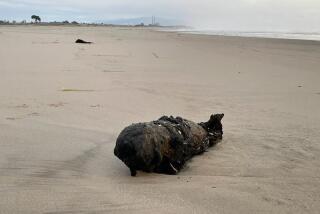Steady nerves and patience: How a bomb squad defused a box of old dynamite in Glendora
- Share via
Many people store things in their basement and forget about them. It’s not often that the forgotten thing turns out to be dynamite.
Such a discovery over the weekend in a Glendora basement in the 200 block of East Bennett Avenue required the Glendora police to evacuate nearby residents and call in Los Angeles County Sheriff’s Department bomb squad.
“It happens, but it is very rare,” said Det. Cindy Valencia, a member of the bomb squad who was dispatched to the scene on Saturday.
According to Valencia, the great-grandson of a deceased homeowner was cleaning out the basement when he stumbled upon 22 sticks of very old dynamite in a cardboard box.
The dynamite had turned grainy and deteriorated to the point that the nitroglycerin, the compound responsible for giving dynamite its punch, had crystallized into wisp-like hairs resembling mold on cheese, Valencia said.
Some sticks had bent and others looked as if they were about to break, said Det. Oscar Corcio, also on the bomb squad.
There was no indication on the wrappers or the box as to the age of the dynamite, but when it gets to that state, “it tells us it has been there a very long time,” Valencia said. “It’s not stable enough to move anymore.”
To neutralize the dynamite, they poured diesel fuel onto the explosive and let it soak for about two hours, a process called desensitizing, Corcio said.
Diesel fuel — not to be confused with gasoline — penetrates the nitroglycerin to make it stable enough to move to a safe area for a controlled burn, Valencia said. This helps ensure that the resulting burn is like a bonfire rather than a boom.
Then came the trickiest part: Corcio, wearing a bomb suit and double latex gloves, had to carry each stick of dynamite by hand to the ditch outside where the controlled burn would take place.
There was still a chance that the unstable dynamite — sensitive to heat, shock and friction — might explode on the way to the ditch.
Corcio, who had taken an advanced disposal training course and volunteered for this part of the disposal, kept his cool but he said he felt like he was inside an oven in his protective suit.
“If you’re not being safe and not being focused, things can go bad really quickly,” Corcio said. “In the same way you pick it up gently, you place it down extremely, extremely gently.”
The entire process took 22 careful trips.
“I think I put in my steps for the day,” Corcio said.
In all, it took about nine hours to dispose of the dynamite.
People use dynamite for all kinds of reasons, primarily for mining and tunneling but also to clear fields, remove tree stumps and even scare away gophers.
“We see it more often in rural areas, places with older homes close to mining areas,” Valencia said.
Nitroglycerin was first synthesized in 1846 by Italian chemist Ascanio Sobrero, who deemed the oily compound too unstable and destructive for use.
Unlike gunpowder, where the fuel and the combustion-promoting oxidant are separate, nitroglycerin has both components built into the same molecule, said Craig A. Merlic, a professor of organic chemistry at UCLA and the executive director of the UC Center for Laboratory Safety.
The resulting reaction happens so fast, he said, because it detonates as a supersonic shock wave as the nitroglycerin compound decomposes into more expansive gases.
Alfred Nobel found a way to mass produce nitroglycerin, which he stabilized in 1867 by mixing the oil with diatomaceous earth so that it formed a paste that could be molded into rods. He used the wealth he generated from selling dynamite to establish the scientific prizes that bear his name.
Prior to its stabilization, in 1866 a leaky shipment of so-called blasting oil shipped from New York exploded and leveled a Wells Fargo building in San Francisco, killing 15 people. An account from a New York Times correspondent compared the force of the blast to both an earthquake and a volcano.
A few weeks earlier, a steamship carrying blasting oil exploded in Aspinwall, Panama, killing 50 people.
When people come across old stashes of dynamite, it’s important that they “don’t touch it, don’t move it, don’t mess with it,” Corcio said. “Because otherwise, it could be a bad day.”
More to Read
Sign up for Essential California
The most important California stories and recommendations in your inbox every morning.
You may occasionally receive promotional content from the Los Angeles Times.











